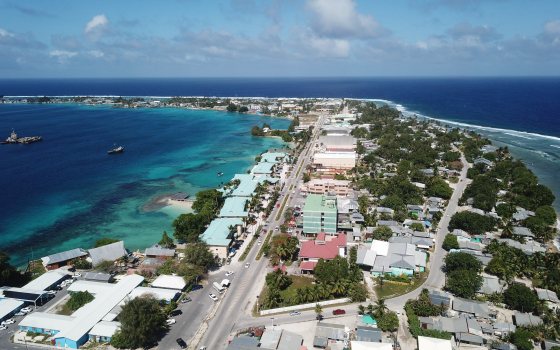The Marshall Islands consist of two chains of 29 coral atolls, and are located north of the equator, between Hawaii and Australia. On each atoll there are a number of islands.
The Marshall Islands have been occupied by humans since the Micronesians arrived in the second millennium BCE. The Marshallese have lived there for thousands of years. In 1914, Japan captured the Marshall Islands and built military bases. In February 1944, U.S. Marine and Army forces defeated Japanese troops on both the Kwajalein and Enewetak atolls. Both atolls were then turned into U.S. military bases. Due to the remote location, sparse population, and other nearby U.S. military bases, the U.S. planned to test powerful nuclear weapons in the Marshall Islands. In 1947, the Marshall Islands became part of the Trust Territory of the Pacific Islands, created by the United Nations and then administered by the U.S. In 1946, the islands had a population of 52,000. Between 1946 and 1958, the United States conducted 67 nuclear tests in the Marshall Islands. The U.S. conducted 23 of these tests at Bikini Atoll, and 44 near Enewetak Atoll, but fallout spread throughout the Marshall Islands.
During the post-World War II period the U.S. expanded their nuclear research and development programs. The U.S. government established the Atomic Energy Commission (AEC) to monitor the peacetime development of atomic science and technology. Fear of the Soviet Union increasing their atomic weapons, and the belief that building up nuclear arms could help establish U.S. power, contributed to this rapid expansion.

Operation Crossroads
The first testing series in the Marshall Islands occurred under Operation Crossroads. The purpose of Operation Crossroads was to investigate the effect of nuclear weapons on naval warships. Testing in the islands began at Bikini Atoll with the Shot Able test, on July 1, 1946. After Shot Able, the Bulletin of the Atomic Scientists confirmed the power of these weapons. They determined that soldiers on ships up to a mile away from this explosion would be instantly be killed. The U.S. then conducted the Shot Baker test on July 25.
These tests were the first time that the U.S. tested nuclear weapons since the Trinity Test in 1945. These were also the first U.S. nuclear detonations since the “Little Boy” and “Fat Man” bombs dropped over Japan. Operation Crossroads ended on August 10, 1946, due to concerns over radiation, especially to the soldiers involved. In 1969, the U.S. began a long term project to decontaminate Bikini Atoll.
Operations Greenhouse and Ivy
In January of 1950, President Truman made the decision to increase U.S. research into thermonuclear weapons, which would lead to further U.S. nuclear testing. Operation Greenhouse was a series of nuclear tests conducted at Enewetak Atoll in 1951. These were done to test design principles that would later become pivotal in the development of the hydrogen bomb. The tests aimed to reduce the overall size of nuclear weapons, including the necessary amount of fissile material, while increasing their destructive power.
The U.S. conducted its first series of thermonuclear tests, Operation Ivy, at Enewetak Atoll, in November of 1952. Shot Mike was the first successful hydrogen bomb test. Then, on November 16, the U.S. conducted the King Shot.
Castle Bravo Test

The U.S. conducted its largest nuclear detonation ever, Castle Bravo, at Bikini Atoll on March 1, 1954. This was part of Operation Castle, a series of thermonuclear tests. Bravo was over 1,000 more times powerful than “Little Boy.” Bravo used a device called “Shrimp” which used lithium deuteride as its fuel. Bravo was the first test of a deliverable hydrogen bomb.
Despite potential risks, Major General Percy Clarkson and scientific director Dr. Alvin C. Graves ordered the test to continue as planned. Due to Castle Bravo radioactive debris was released into the atmosphere, and to surrounding atolls. The test was more powerful than scientists predicted. Ocean currents, weather conditions, and wind patterns contributed to this spread of fallout and debris. The fallout was composed of pulverized coral, water, and radioactive particles, and it fell into the atmosphere appearing as ashy snowflakes. This affected nearby atolls and U.S. servicemen. Traces of radioactive material were later found in parts of Japan, India, Australia, Europe, and the United States. This was the worst radiological disaster in U.S. history and caused worldwide backlash against atmospheric nuclear testing.
Relocation of the Marshallese
In 1946, Navy Commodore Ben Wyatt met with the 167 people living on Bikini Atoll. Wyatt asked the Marshallese to relocate, and for use of their atoll “for the good of mankind.” He explained that they were a chosen people and that perfecting atomic weapons could prevent future wars. The residents were promised they could return one day, but realistically they had no choice in this matter. Immediately following this speech, the U.S military began preparations to relocate the residents to Rongerik Atoll, an uninhabited island with limited resources 125 miles away. Residents of Bikini Atoll resettled in 1969, but then evacuated in 1978, after radiation levels were determined to be excessive.

A month later, the Marshallese filed a complaint with the UN, but this did not prevent U.S. nuclear testing. In 1948, the U.S. government forced residents of Enewetak Atoll to evacuate due to expanded nuclear testing with Operation Sandstone.
A week after the Castle Bravo test, the U.S. launched a medical study on the effects of radiation on Marshallese, and provided medical care to the people who were exposed to high levels of radiation. Led by Eugene P. Cronkite, the effort was called Project 4.1. Today, scholars criticize Project 4.1 because researchers did not acquire informed consent from the Marshallese who participated. “The team conducting the study did not ask the Marshallese for their consent or even explain to them that a study was being conducted,” historian April Brown wrote in a 2014 article for Arms Control Today.
Despite the fact that residents of Enwetak Atoll were relocated to Rongelap, Utirik, and Ailinginae Atolls, they were all exposed to nuclear fallout, primarily as a result of the Castle Bravo test. Rongelap Atoll is just one example of how nuclear fallout and relocation affected the Marshallese. In 1954, as a result of the Castle Bravo test, many residents here suffered from burns and radiation diseases. The military did not evacuate residents until two days after the test occurred. Then, in 1957, the people of Rongelap returned. However, officials and scientists working for the AEC concluded that radiation was still a risk.
After the release of previously classified documents, the public learned that some scientists and researchers within the AEC had goals of studying humans living in radiation contaminated environments. Based on these documents this may have influenced the decision to allow the Marshallese of Rongelap to return back to the Atoll in 1957. For instance, an AEC scientist at a meeting where the decision to allow Marshallese to return to Rongelap was made stated, “It would very interesting to go back and get good environmental data, when people live in a contaminated environment. Now, data of this type has never been available. While it is true that these people do not live, I would say, the way Westerners do, civilized people, it is nevertheless also true that they are more like us than the mice.” By 1985 Marshallese fled Rongelap Atoll due to high levels of contamination. The U.S. in the 1990s began to clean up part of Rongelap Atoll, under a $45 million program, but many Marshallese do not wish to return.
Health Concerns
As the nuclear testing occurred, the Marshallese were not aware of the potential dangers. A Senator of the Marshall Islands Parliament, Jeton Anjain, explained the effects of Castle Bravo, “Five hours after detonation, it began to rain radioactive fallout at Rongelap. The atoll was covered with a fine, white, powder- like substance. No one knew it was radioactive fallout. The children played in the ‘snow.’ They ate it.” 
Since U.S. nuclear testing began, there has been concern over the health risks that occur as a result of fallout and radiation. Many Marshallese have suffered from forced relocation, burns, birth defects, and cancers. Researchers have conducted numerous studies on the health effects of nuclear tests conducted by the U.S. in the Marshall Islands. In 2005, the National Cancer Institute reported that that the risk of contracting cancer for those exposed to fallout was greater than one in three. Many adults developed cancerous thyroid nodules, two or three decades after the testing ended. In 2010, the National Cancer Institute reported, “As much as 1.6% of all cancers among those residents of the Marshall Islands alive between 1948 and 1970 might be attributable to radiation exposures resulting from nuclear testing fallout.” They also suggested that up to 55% of all cancers in the northern atolls are a result of nuclear fallout. They concluded that this was a result of the Castle Bravo test.
Tony deBrum, a Castle Bravo test witness and former Foreign Minister of the Marshall Islands, argued that the U.S. nuclear testing caused numerous health and infrastructure issues for the Marshallese. He commented that nuclear test victims “have been taken from us before their time,” so the U.S. could learn more about the “effects of such evil and unnecessary devices.”
U.S. Government Reponses and Compensation
In the 1970s, the U.S. began cleaning up Enewetak Atoll to make it habitable again. Then, the majority of the Marshallese people voted to establish a new political relationship with the U.S. The Marshall Islands became the Republic of the Marshall Islands (RMI) in 1979.

In 1986, the U.S. and the RMI signed the Compact of Free Association, which granted the RMI political independence and allows Marshallese citizens to work and go to school in the U.S. The U.S. also is responsible for the defense of the RMI, and is permitted to conduct military maneuvers and testing on Kwajalein Atoll. The Compact also ensures that the U.S. provides medical care for the remaining 176 Marshallese directly affected by the Castle Bravo test. The U.S. government defines the atolls affected by radiation as Bikini, Enewetak, Utirik, and Rongelap, and they have concluded that those affected were the residents present during the testing period. This definition does not take into account the long lasting effects of radiation, the frequent movement of the Marshallese between various atolls, or those who did not live on the Marshall Islands during the testing period, who were affected.
The Marshall Islands Nuclear Claims Tribunal was designed under the Compact to award compensation for cancers and other serious health effects, such as burns and birth defects, attributed to nuclear testing. The U.S. established a $150 million compensation trust fund for those affected. This included individual trust funds for Bikini, Enewetak, Rongelap, and Utirik. The trust funds help cover health and property damages. The U.S. Embassy website today explains that the U.S. government is “committed to a full and open collaboration with the Republic of the Marshall Islands in radiological monitoring, rehabilitation of affected atolls, and nuclear related health care assistance.” The Embassy in Majuro states on its website: “The U.S. never intended for Marshallese to be hurt by the tests.”
In the 1990s, the Advisory Committee on Human Radiation Experiments (ACHRE), with the use of available government documents and witness interviews, concluded that there was no evidence “to support the claim that the exposures of the Marshallese, either initially or after resettlement, were motivated by research purposes.”
RMI Today
The radiological legacy of U.S. nuclear weapons testing in the Marshall Islands still affects the Marshallese today. U.S. nuclear testing ended in the Marshall Islands in 1958, but a UN report in 2012 stated that the effects of this testing are long-lasting. The city of Majuro is now home to the majority of the Marshallese population. Today, radiation related cancers and birth defects are a major problem faced by the Marshallese. The RMI also struggles with high suicide rates and high alcoholism rates. Diabetes (due to large amounts of imported, processed food) and cancer are the top two causes of death. Environmental issues such as rising sea levels, and degradation attributed to the nuclear testing, are also problems and often force residents to move between atolls.

Remembrance Day, March 2, is now an official holiday in the RMI. This holiday honors the victims and survivors of the nuclear testing. There are many activists in the RMI who want to ensure the protection of future generations, and to ensure that the U.S. government pays the settlements. They work to raise awareness of current health and political issues the RMI faces, due to past nuclear testing. Lani Kramer, a Marshallese councilwoman, stated, “As a result of being displaced we’ve lost our cultural heritage- our traditional customs and skills, which for thousands of years were passed down from generation to generation.” RMI president Christopher Loeak stated that U.S. compensation “does not provide a fair and just settlement” for the damage caused by nuclear testing.
In 2014, the RMI attempted to sue the U.S. and eight other nuclear armed nations. The RMI filed the “Nuclear Zero Lawsuit,” claiming that the countries have failed to move towards nuclear disarmament. The RMI did not seek monetary compensation, or cleanup operations. Instead the RMI wanted the nations to comply with the Nuclear Non-Proliferation Treaty, meaning that nations should work to decrease their nuclear arms, and that nuclear power should only promoted for peaceful uses. In 2017, the U.S. Ninth Circuit Court dismissed the lawsuit.
According to a 2016 Columbia University study, radiation levels in some areas of the Marshall Islands are almost double of what is deemed safe for human habitation; but overall the islands are slowly becoming less radioactive. Very few Marshallese today live on Rongelap and Enewetak Atolls. Scientists visit Bikini Atoll, and a few caretakers live there. It is not clear when the Marshall Islands will be radiation free, or if people will return to Bikini Atoll. Radiation levels and climate change have led to overcrowding in the capital city of Majuro. Cleanup efforts continue throughout the islands and the Marshallese continue to advocate for compensation.
Timeline of Major Nuclear Tests Conducted at the Marshall Islands:
7/1/1946: Testing begins at the Marshall Islands, with Shot Able.
7/25/1946: Shot Baker is conducted, under Operation Crossroads.
4/30/1948: Shot Yoke, under Operation Sandstone, is conducted. This was the first fission weapon to use a levitated core design.
4/20/1951: Shot Easy nuclear test is conducted at Enewetak Atoll, under Operation Greenhouse. The Easy test was meant to test a new, lighter implosion bomb.
5/1951: Operation Greenhouse testing occurred at Enewetak Atoll.
11/1/1952: The Mike Shot is conducted at Enewetak, under Operation Ivy. This was the first U.S. thermonuclear test.
6/28/1958: The Oak test is conducted, at Enewetak Atoll, under the Operation Hardtack I series. This was the 6th largest U.S. nuclear test. Hardtack I included 35 total tests. Hardtack I was the last testing series conducted on the Marshall Islands.
Aelōn̄ eo ao ion lometo;
Einwot wut ko lōti ion dren elae;
Kin meram in Mekar jen ijo ilan̄;
Erreo an romak ioir kin meram in mour;
Eltan pein Anij eweleo im wōj;
Kejolit kij kin ijin jikir emol;
Ijjamin Ilok jen in aō lemoran;
Anij an ro jemem wonakke im kejrammon Aelin̄ kein ad.
And here’s the English translation:
My island (heart) lies o’er the ocean;
Like a wreath of flowers upon the sea;
With a (the) light of Maker from far above;
Shining with the brilliance of rays of life;
Our Father’s wondrous creation;
Bequeathed to us, our Motherland;
I’ll never leave my dear home sweet home;
God of our forefathers protect and bless forever Marshall Islands.
Many Marshall Islands holidays have similar counterparts in the United States. During the same weekend North Americans observe Labor Day, Marshallese celebrate Rijerbal Day in honor of the islands’ working class. Another national holiday, Gospel Day, is similar to Thanksgiving, with a stronger emphasis on church services. Manit Day, however, celebrates the Marshallese’s own distinct culture. Sailing races and fishing tournaments are among the islands’ most popular sporting events.
Marshall Islands Memorial and Nuclear Victims Day
This tribute to the victims of the 1954 Bikini Atoll hydrogen bomb explosion ranks among the most serious of all Marshall Islands holidays. Bravo was the most powerful hydrogen bomb the United States had ever tested. People on no fewer than four atolls were forced to evacuate and several experienced severe radiation poisoning. March 1 is a day of prayer, emotional speeches, candlelight vigils, and somber reflection for the current residents of those atolls.
Liberation Day
Each of the Marshall Islands celebrates the anniversary of the day the United States liberated each individual island from Japan during WWII on different days and in their own unique ways. The main Liberation Day event in Majuro is an exciting canoe race, while the atoll of Kwajalein celebrates its Liberation Day with a lively parade, flag waving and a field day between all local schools on Ebeye Beach.
Coconut Cup Regatta
Sailing crafts of all sizes from luxury yachts to traditional Marshallese canoes, are welcome to participate in this unique regatta held in Majuro between late March and early April. Even windsurfers can take part in the main Saturday afternoon race, which follows a triangular pattern to and from the Robert Reimers Enterprises complex. There are also races for miniature canoes called riwut and vessels built entirely from recycled materials. A weekend affair, prizes are awarded on Saturday, a picnic takes place on Sunday and the Marshall Islands Resort hosts a soirée on Monday.
Marshall Islands Constitution Day
May 1 is the anniversary of the day the first Marshall Islands constitution was signed. This was one of the first steps towards complete independence, and today, its people remember this significant event through parades, wreaths and field day competitions among local schools.
Fisherman’s Day
On the first Friday of each July, the Marshalls Billfish Club hosts this exciting fishing competition where vessels depart in the morning and return in the early evening to have their catches weighed and measured. Anglers receive prizes for the heaviest fish, biggest fish, largest number caught, and many more.
Mobil All Micronesia Fishing Tournament
Labor Day weekend in North America is the same weekend the Marshall Islands pays tribute to its working class during Rijerbal Day, held on the first Friday of September. This Marshalls Billfish Club-sponsored fishing tournament is one of the most exciting national holidays. Teams from across Asia and the South Pacific fight to catch the biggest bite at the Uliga Dock on Saturday and Sunday, and receive awards at the Marshall Islands Resort Poolside on Sunday.
Manit (Custom) Day
The most important aspect of Marshall Islands culture, family, is the focus of this cultural festival held the last Friday of September. Anyone on the islands can set up booths and sell food or handicrafts outside the Alele Museum. Basket weaving and coconut husking are among the most popular contests. Local school children perform traditional dances, skits, songs, and stories. The day coincides with the week-long Lutok Kobban Alele festival created to preserve and promote Marshallese culture.
Gospel Day
On the first Friday of December, the population of the Marshall Islands celebrates this national holiday in honor of the American missionaries who brought Christianity to the isolated islands. Like Thanksgiving in North America, family and food are a main focus, but church services play an even more important role in Gospel Day.







[…] the Pacific. Kiribati made headlines in the 1950’s and ‘60s as the spot where the UK and US tested thermonuclear weapons near Christmas […]